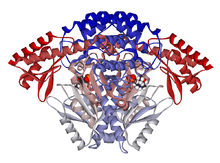Aromatic L-amino acid decarboxylase
Aromatic L-amino acid decarboxylase (EC 4.1.1.28, synonyms: DOPA decarboxylase, tryptophan decarboxylase, 5-hydroxytryptophan decarboxylase, AAAD,[2] AADC) is a lyase enzyme.
Reactions
It catalyzes several different decarboxylation reactions:[3]
The enzyme uses pyridoxal phosphate, the active form of vitamin B6, as a cofactor.
Human biosynthesis pathway for trace amines and catecholamines
[4][5]

Human serotonin biosynthesis pathway
As a rate-limiting step
In normal dopamine and serotonin (5-HT) neurotransmitter synthesis, AAAD is not the rate-limiting step in either reaction. However, AAAD becomes the rate-limiting step of dopamine synthesis in patients treated with L-DOPA (such as in Parkinson's Disease), and the rate-limiting step of serotonin synthesis in people treated with 5-HTP (such as in mild depression or dysthymia). AAAD is inhibited by Carbidopa outside of the blood brain barrier to inhibit the premature conversion of L-DOPA to Dopamine in the treatment of Parkinson's.
In humans, AAAD is also the rate-limiting enzyme in the formation of trace amine neurotransmitters.
Genetics
The gene encoding the enzyme is referred to as DDC and located on chromosome 7 in humans.[6] Single nucleotide polymorphisms and other gene variations have been investigated in relation to neuropsychiatric disorders, e.g., a one-base pair deletion at –601 and a four-base pair deletion at 722–725 in exon 1 in relation to bipolar disorder[7] and autism. No direct correlation between gene variation and autism was found.[8]
See also
References
- ↑ PDB: 1JS3; Burkhard P, Dominici P, Borri-Voltattorni C, Jansonius JN, Malashkevich VN (November 2001). "Structural insight into Parkinson's disease treatment from drug-inhibited DOPA decarboxylase". Nat. Struct. Biol. 8 (11): 963–7. doi:10.1038/nsb1101-963. PMID 11685243.
- ↑ Logan, Carolynn M.; Rice, M. Katherine (1987). Logan's Medical and Scientific Abbreviations. Philadelphia: J. B. Lippincott Company. p. 3. ISBN 0-397-54589-4.
- ↑ "AADC". Human Metabolome database. Retrieved 17 February 2015.
- ↑ Broadley KJ (March 2010). "The vascular effects of trace amines and amphetamines". Pharmacol. Ther. 125 (3): 363–375. doi:10.1016/j.pharmthera.2009.11.005. PMID 19948186.
- ↑ Lindemann L, Hoener MC (May 2005). "A renaissance in trace amines inspired by a novel GPCR family". Trends Pharmacol. Sci. 26 (5): 274–281. doi:10.1016/j.tips.2005.03.007. PMID 15860375.
- ↑ Lisa J. Scherer, John D. McPherson, John J. Wasmuth and J. Lawrence Marsh (June 1992). "Human dopa decarboxylase: Localization to human chromosome 7p11 and characterization of hepatic cDNAs". Genomics 13 (2): 469–471. doi:10.1016/0888-7543(92)90275-W. PMID 1612608.
- ↑ A. D. Borglum, T. G. Bruun, T. E. Kjeldsen, H. Ewald, O. Mors, G. Kirov, C. Russ, B. Freeman, D. A. Collier & T. A. Kruse (November 1999). "Two novel variants in the DOPA decarboxylase gene: association with bipolar affective disorder". Molecular Psychiatry 4 (6): 545–541. doi:10.1038/sj.mp.4000559. PMID 10578236.
- ↑ Marlene B. Lauritsen, Anders D. Borglum, Catalina Betancur, Anne Philippe, Torben A. Kruse, Marion Leboyer & Henrik Ewald (May 2002). "Investigation of two variants in the DOPA decarboxylase gene in patients with autism". American Journal of Medical Genetics 114 (4): 466–460. doi:10.1002/ajmg.10379. PMID 11992572.
External links
|
|---|
| | Activity | |
|---|
| | Regulation | |
|---|
| | Classification | |
|---|
| | Types | |
|---|
|


